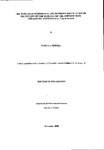THE EFFECTS OF HYDROLOGY AND NUTRIENT INPUTS AT SOUTH MILTON LEY ON THE ECOLOGY OF THE COMMON REED PHRAGMITES AUSTRALIS (Cav. Trin. ex Steudal)
| dc.contributor.author | POWELL, PAULA ANGELE | |
| dc.contributor.other | School of Geography, Earth and Environmental Sciences | en_US |
| dc.date.accessioned | 2013-10-07T11:06:24Z | |
| dc.date.available | 2013-10-07T11:06:24Z | |
| dc.date.issued | 2000 | |
| dc.identifier | NOT AVAILABLE | en_US |
| dc.identifier.uri | http://hdl.handle.net/10026.1/2061 | |
| dc.description.abstract |
South Milton Ley is a small coastal wetland in Southern England. A sand-bar forms periodically at its seaward end and separates fresh water from the sea. The common reed Phragmites australis dominates the wetland and when a sand bar is present a shallow freshwater lake forms. Monthly water budgets were prepared for the years 1994, 1995 and 1996 and intermittent flooding of the Ley was also monitored. This information was used to calculate a range of residence times (between one hour and eleven days) and the characteristics of various flow regimes when the sandbar, which dams the Ley, is open or closed. Reed growth and the lake's ecology are potentially influenced by effluent from a sewage treatment works (STW) that discharges into the wetland. Water chemistry and hydrology of the wetland have been studied alongside experiments to investigate any effects of nutrient enrichment from the STW on reed growth. Inflowing and outflowing waters were analysed in order to determine concentrations of total oxidised nitrogen (TON), total dissolved nitrogen (TDN), soluble reactive phosphorus (SRP), total dissolved phosphorus (TDP) and potassium (K). Over the study period the annual load of SRP to the Ley increased from 3.65 gmˉ² aˉ¹ in 1992 to 8.1 gmˉ² aˉ¹ in 1996. TON load rose from 69.35 g mˉ² aˉ¹ in 1992 to 104.8 g mˉ² aˉ¹ in 1996. K fell from 97.3 g mˉ² aˉ¹ in 1994 to 96.4 g mˉ² aˉ¹ in 1996. The STW uses a Reedbed Treatment System (RBTS) to 'polish' its final effluent. The efficiency o f the RBTS was studied and during 1996 the efficiency rate for T ON was 20.9% and for SRP was 9.3%. Measurements of height, diameter, numbers of internodes, density and biomass of reeds collected from South Milton Ley were undertaken during August 1994 and 1995. Results of analyses for 1994 indicate that reeds were thinner and possessed fewer seedheads than those of 1995 but that density was greater. Reed fieldwork during 1994 found that height, diameter, numbers of internodes, biomass and number of seedheads were greater below the STW than above. During 1995 only seedhead production was greater below the outlet. The wettest area of the Ley contained reeds with greatest height and diameter. The driest area produced a higher density of reed growth. Laboratory experiments suggested that low N:K ratios and high P:K produced taller plants. Data from reed fieldwork together with results from hydrology and water chemistry studies were used in a statistical analysis in order to determine which, if any of these factors caused changes in reed growth. A conclusive link between water chemistry, hydrology and plant variables was not found. Correlation analysis for 1994 indicated that high concentrations of SRP and TON could produce thin reeds with low biomass. Analysis for 1995 suggested that elevated K values could produce a high density of short reeds. Water depth was found to have a significant effect (P < 0.001) on diameter. The key factors for reed decline (high water levels from spring to winter which can inhibit reed regeneration and increase residence times, increasing nutrient loads and changes in the ratio of N:P:K which could alter reed growth) are all present. At its present loading the Ley is nutrient rich and does not appear to be buffering wetland waters. After data analysis and fieldwork was completed a bloom of Oscillatoria sp.occurred at the seaward end of the Ley during August 1999. This, the first know occurrence of a bloom may be an indication that changes in the ecosystem of South Milton Ley are occurring. For the future, a programme of nutrient reduction, hydrological management and growing knowledge of wetland processes may prevent adverse changes. | en_US |
| dc.language.iso | en | en_US |
| dc.publisher | University of Plymouth | en_US |
| dc.title | THE EFFECTS OF HYDROLOGY AND NUTRIENT INPUTS AT SOUTH MILTON LEY ON THE ECOLOGY OF THE COMMON REED PHRAGMITES AUSTRALIS (Cav. Trin. ex Steudal) | en_US |
| dc.type | Thesis | |
| plymouth.version | Full version | en_US |
| dc.identifier.doi | http://dx.doi.org/10.24382/4896 | |
| dc.identifier.doi | http://dx.doi.org/10.24382/4896 |
Files in this item
This item appears in the following Collection(s)
-
01 Research Theses Main Collection
Research Theses Main


